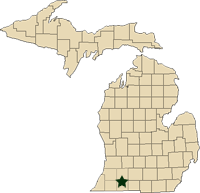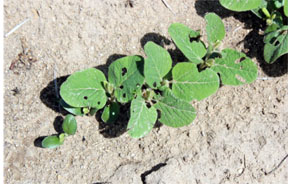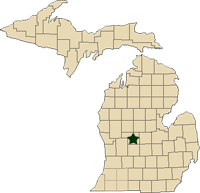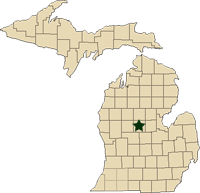Regional Reports on Michigan Field Crops – May 26, 2011
MSU Extension educators’ pest and field crop updates for Michigan.
This week’s regional reports:
- Southeast Michigan – Ned Birkey
- Southwest Michigan – Bruce Mackellar
- West Central Michigan – Fred Springborn
- Central Michigan – Paul Gross
Southeast Michigan – Ned Birkey, Michigan State University Extension
|
Weather continues to be “unsettled” with some scattered but locally heavy hail coming Sunday night (May 22) and Monday afternoon. Farmers had Monday and Tuesday to get some fieldwork done, but steady to heavy rains moved in on Wednesday and are forecast for Thursday and Friday. One good thing is that the soil temperature is in the low 60s, so planted crops are emerging quickly. As usual, it seems for this particular weekend, hot temperatures of at or near 90 degrees, is forecast for Sunday and Memorial Day.
Alfalfa is not cut yet because of all the rain.
Corn planting resumed Monday, Tuesday and early Wednesday before the rains came. This area is perhaps half-planted with most planted corn spiking through and up to the v1 leaf stage. Fourth instar black cutworms are present and can cause severe damage in fields that were weedy and a great location for black cutworms to lay their eggs earlier this spring.
Soybean planting resumed earlier this week and is perhaps half done. Fields that are emerged have young plants at the VC stage. Many fields that are not planted are being tilled for weed control and soil bed preparation.
Wheat is at the Feekes’ growth stage 9 with flag leaves fully emerged. Septoria leaf spot and powdery mildew are present and fungicide spraying continues and likely will through flowering to guard against Fusarium head blight or scab.
Pre-sidedress nitrate nitrogen soil tests will be taken to MSU on Wednesdays in June, starting June 8. Dry soil samples that are sent to the Monroe County MSU Extension office on Tuesday should have the results back no later than Friday.
A pre-harvest field day will be held Wednesday, June 22, 5:00 to 8:00 PM at the MSU Wheat Variety trial location in Lenawee County. The plots are located on Bucholtz Highway, north of Deerfield.
Southwest Michigan – Bruce Mackellar, Michigan State University Extension
|
Drying conditions over the weekend of May 21 and early this week allowed producers narrow windows of opportunity for planting. Heavy thunderstorms moved into the area from the south on May 25, producing a lot of rainfall in several events with precipitation totals ranging from 1.5 to 4 inches over much of the region. Soils are once again saturated in most of southwest Michigan. Temperatures are expected to be in the 50s today (May 26). The cold snap is expected to be short lived, however, with temperatures in the mid-80s expected over the Memorial Day weekend.
Temperatures and GDD accumulations
The normal heat accumulation (Base 50 GDD’s) is around 12.5 per day for the next five days, and then increases to 13.5 per day over the next five. Most Enviro-weather stations are reporting 250-290 GDD’s Base 50 accumulation since May 1. The 6 to 10 day and 8 to 14 day outlooks from NOAA are calling for above normal temperatures.
Precipitation summary
Precipitation levels over the last seven days are in the 2 to 4 inch range over southwest Michigan, with areas of Berrien, Van Buren, Allegan and Barry counties receiving more. Both the 6 to 10 day and 8 to 14 day outlooks have southwest Michigan in the normal precipitation zones. Hopefully, this will allow some of the wet soils a chance to dry out and for planting operations to get underway, especially in those areas that are so far behind in field work.
Alfalfa has been one of the bright spots in crop growth. Alfalfa is now at the bud stage, and producers are ready to harvest first cutting if a weather window provides them with the chance. Potential yields look good. Many growers have treated for alfalfa weevil because of the wet conditions and uncertainty of when the crop will be harvested. Base 41 GDD’s for alfalfa development range from 600 to 770 across the area. Once fields have been harvested, it is important to monitor for alfalfa weevil and potato leafhoppers. Both of these insect pests have the potential to damage early regrowth alfalfa.
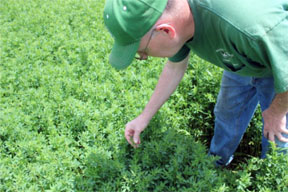
Dairy producer Tim Hood checking for alfalfa bud development on one of his fields near Paw Paw on May 24.
Wheat continues to look good. Advanced fields are fully headed out, but flowering has not yet occurred. Powdery mildew can be found on the upper two leaves of some plants in many fields. With the plants rapidly approaching flowering, the conditions during the next week to 10 days are likely to set the stage for Fusarium head blight (scab) infection. The fungicide application window will occur in the next couple of days in advanced fields. To help you to make a decision on if and what fungicide to spray, refer to MSU wheat educator Martin Nagelkirk’s article, Managing Fusarium head blight on wheat.
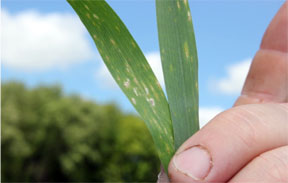

Corn planting once again is at a standstill. However, overall planting progress has been pretty good in sandier portions of southwest Michigan. Corn planted before May 1 is between V3-V4. We did see some challenges with delayed and uneven emergence in fields that were Kalamazoo Loam and heavier. I think that final stands on these fields will end up being good. Corn plant color improved greatly with the warmer weather. Herbicide applications are behind schedule, with many fields showing signs of small weeds growing. Be sure to keep track of the size of the grass weeds if you are counting on a delayed preemergence weed control program. Grass weeds greater than 0.75 to 1 inch in height are less likely to be controlled by delayed pre-grass programs.
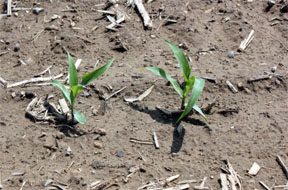
With much warmer temperatures expected over the weekend, both the crop and the weeds can quickly outgrow your planned delayed preemergence program. I have also seen some very light cutworm feeding damage in a couple of fields, all well below the threshold for treatment. MSU Extension Educator Fred Springborn also notes that many other critters, particularly geese, turkeys and sandhill cranes, can cause clipping like damage in corn. We certainly have seen issues with sandhill cranes and Canada Geese in many southwest Michigan fields over the past several years. For those of us that are having challenges getting corn in the ground, MSU Agronomist and Bio-Fuel Crops Specialist Kurt Thelen wrote an excellent article on switching to shorter maturity corn to optimize profits and minimize risk of not reaching black layer by the first frost.
Seed corn planting is underway. Wet conditions and wide swings in temperatures have been causing headaches in getting the male-female planting delays established on schedule.
Soybeans planted around May 1 are starting to set their first tri-foliate leaves. Stands continue to look good. Not much sign of seedling diseases yet. There are some signs of adult bean leaf beetle feeding on soybean seedlings. I also would encourage producers to continue to monitor for black cutworm activity. For the many producers that have been struggling to get soybeans planted, MSU Extension’s Mike Staton has put together an excellent resource on things to consider when planting late season soybeans.
Crop insurance
While we have described reasonably normal growing conditions for some areas, there are many areas in our region that have not been able to get fields worked or planted. MSU Farm Financial Educators Roger Betz and Dennis Stein have been working on outreach programs and articles to help producers to understand their options under the prevented planting provisions in their crop insurance programs. There are some very important deadlines to file with your crop insurance agents, so I would encourage producers to learn more about these and to file claims in a timely manner.
West Central Michigan – Fred Springborn, Michigan State University Extension
|
Wet weather continues in much of the west central region, hindering and delaying field work in many areas. Standing water is common in low areas of fields. Yes, I am writing a fresh report even though those first two lines have remained the same. We are getting a break here and there to get some field work done, however, most areas are far behind normal with livestock farms seeming to be the furthest behind due to the need to haul and apply manure. Low soil temperatures are in the mid to upper 50s. High air temperatures have ranged from the mid-80s on Sunday (May 22) to the mid-50s yesterday (May 25).
Corn growth stage ranges from still in the bag to V2. Color of emerged corn has improved dramatically in many cases with the higher temperatures and sunshine over the weekend. Corn that is emerging this week will likely have the same pale color as clouds and cool temperatures have returned. Overall, only 50 to 60 percent of corn is planted while a few growers are nearly finished planting, but many more have very little planted.
We are getting a number of reports of clipped corn. Before you load your sprayer with insecticide, verify that it is cutworm damage and not clipping from other causes. In other words, you can’t have your cutworm cake until you have your goose dinner!
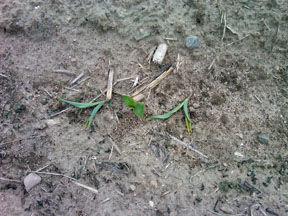
Clipped corn.
Alfalfa is growing quite well with many fields at 24 inches in height. Still very little alfalfa weevil or damage has been observed.
Wheat is at Feekes’ 8 to 9 and quite variable. Nitrogen deficiency is observed in a number of fields due to volatilization of N applied earlier or inability to make an N application. Disease pressure is quite low in most varieties, and powdery mildew is commonly observed low in the canopy on highly susceptible varieties.
Soybean planting is underway with a fraction of the crop planted and little emerged.
Potato planting is approximately 50 to 60 percent complete, and early planted potatoes are emerging. Volunteer potatoes are also emerging.
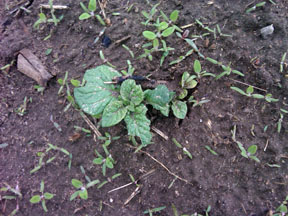
Volunteer potatoes are emerging.
Central Michigan – Paul Gross, Michigan State University Extension
|
Weather
Farmers across the region were able to get back into the fields late last week and over the weekend. Planting progress was very good until Wednesday (May 25) rains brought field work to a halt. Rain amounts during the past week exceeded 1.5 inches in some parts of the region. If the weather forecast of seven to eight days of good weather is reliable, farmers should be able to plant most of their remaining acres. Some fields will just not dry out and will qualify for prevented planting. Most are reporting planting in less than ideal conditions.
Commodity reports
The corn crop is about 70 percent planted across the region. The early planted corn has emerged and in the 2-3 leaf stage. At this point the emerged corn looks very good with uniform stands. There have been reports of billbugs. Weeds are growing rapidly and if not controlled will be competing with the crop soon. It will be important to scout fields for emergence and other problems.
Soybean planting is following closely with corn with about 50 percent of the crop planted. The early planted beans have emerged and have their first unifoliate leaves. There is concern about the potential for seedling diseases with all the rain and saturated soils. Scout fields for crop problems. Control weeds as soon as possible.
The wheat crop is progressing with flag leaves emerging and the early planted fields in the boot stage. Powdery mildew has been found in several fields and is moving up the plant. In the most severe cases it is on the leaf below the flag leaf. It will be important to manage foliar diseases in this year’s crop. The yield potential is very good, so it must be protected. Refer to the article Managing Fusarium head blight on wheat at the MSU Extension News for Agriculture site for more information.
Alfalfa is nearing optimum nutritional stages. We are getting PEAQ stick reading of 35-37 NDF. Most stands are very good with no problems reported. The yield potential looks good. Some dairy farmers have begun harvest. Most fields will be ready to harvest early next week. Harvesting at peak nutritional values assures the highest quality forages.
Oats and barley are progressing rapidly with no problems reported. New seedings are doing well with the adequate moisture.



 Print
Print Email
Email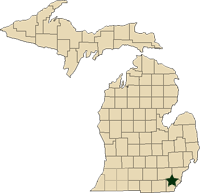 Southeast Michigan
Southeast Michigan